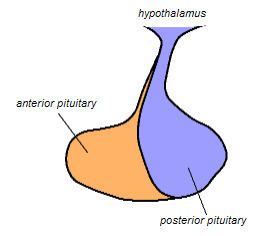Vein hypophyseal vein NeuroLex ID Neurohypophosis | MeSH A06.407.747.734 | |
 | ||
Artery inferior hypophyseal artery Latin Pars nervosa glandulae pituitariae,pars nervosa hypophyseos,lobus posterior hypophyseos | ||
The posterior pituitary (or neurohypophysis) is the posterior lobe of the pituitary gland which is part of the endocrine system. The posterior pituitary is not glandular as is the anterior pituitary. Instead, it is largely a collection of axonal projections from the hypothalamus that terminate behind the anterior pituitary which serves as a site for the secretion of neurohypophysial hormones (oxytocin and vasopressin) directly into the blood. The hypothalamic–neurohypophyseal system is composed of the hypothalamus (the paraventricular nucleus and supraoptic nucleus), posterior pituitary, and these axonal projections.
Contents
Structure
The posterior pituitary consists mainly of neuronal projections (axons) of magnocellular neurosecretory cells extending from the supraoptic and paraventricular nuclei of the hypothalamus. These axons store and release neurohypophysial hormones oxytocin and vasopressin into the neurohypohyseal capillaries, from there they get into the systemic circulation (and partly back into the hypophyseal portal system). In addition to axons, the posterior pituitary also contains pituicytes, specialized glial cells resembling astrocytes assisting in the storage and release of the hormones.
Classification of the posterior pituitary varies, but most sources include the two regions below:
The median eminence is only occasionally included as part of the posterior pituitary. Other sources specifically exclude it from the pituitary.
A few sources include the pars intermedia as part of the posterior lobe, but this is a minority view. It is based upon the gross anatomical separation of the posterior and anterior pituitary along the cystic remnants of Rathke's pouch, causing the pars intermedia to remain attached to the neurohypophysis.
Hormone secretion
Two hormones are classically considered as being related to the posterior pituitary: oxytocin and vasopressin. These hormones are created in the hypothalamus and released in the posterior pituitary. After creation, they are stored in neurosecretory vesicles regrouped into Herring bodies before being secreted in the posterior pituitary via the bloodstream.
Clinical significance
Insufficient secretion of vasopressin underlies diabetes insipidus, a condition in which the body loses the capacity to concentrate urine. Affected individuals excrete as much as 20 liters of dilute urine per day. Oversecretion of vasopressin causes the syndrome of inappropriate antidiuretic hormone (SIADH).
